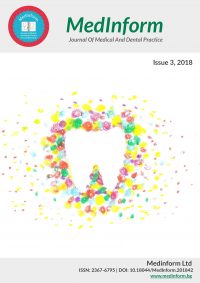Issue Three 2018
2018, Vol. 5 issue 3, (September)
Original Article
HBV DNA loss in Bulgarian patients on nuc therapy. Speed related factors
Abstract:
Introduction
Approximately 250 million people worldwide are infected with hepatitis B virus (HBV). In Bulgaria data reveal a frequency of HBV infection between 2 and 4 % among the population. With the current therapeutic regimes, we manage to stop viral replication in most of the patients, but not to eradicate the virus.
Aim
The aim of the present study was to determine the time for serum HBV DNA loss in different therapeutic regimes with nucleoside/nucleotide analogues (NUC) in Bulgaria.
Materials and methods
We analyzed data from 427 patients (304 males and 123 females) treated in the Clinic of Gastroenterology, UMHAT” St. Ivan Rilski”, Sofia. All included patients had chronic HВV-infection and had received antiviral NUC therapy for at least 1,5 years. Disease burden was defined clinically and histologically. Patients were followed-up clinically, biochemically and the viral load was determined by a PCR-method. Data were processed by a descriptive analysis, non-parametric tests (Mann-Whitney U, Wilcoxon Chi-square) and correlative analysis (Spearman, Pearson, Kendall).
Results:
The median patient age was 51,83 ± 12,99 years. 94 (22%) were HBeAg(+) positive and 333 (78%) were HBeAg(-) negative. 111 (26%) patients had liver cirrhosis and 316(74%) had chronic hepatitis (244 – F0-F2 stage, and 72 -F3 stage). HBV DNA LOSS was achieved in 409 (95,7%) patients for a median period of 8,4 months. In 18 patients (4,3%) HBV DNA loss was not achieved (14,9 % of HBeAg(+) patients and 0,3% of the HBeAg (-) group). Cirrhotic patients had the fastest HBV DNA loss (6,1 months) irrespectively of their sex, age, therapeutic regime or viral load (p<0,0001). Patients treated with Tenofovir and Entecavir had slower loss than those, treated with Lamivudin (p<0,0001). The latter group had lower viral load at baseline, and 9,4% were HBeAg(+). Significant correlation was established between the HBV DNA loss rate and the viral load (p<0,0001).
Conclusion
In our patients the viral response rate depended on the viral load and HBeAg status. No influence of therapeutic regime was established. Patients with liver cirrhosis had the fastest HBV DNA serum loss, though they did not have the lowest viral load. In HBe negative group older women (above 60) had the slowest viral loss and the older men had the fastest. In HBe(+) group the patient number is small for determination of sex differences, but there is a tendency for slower (approximately 16 months) loss in the youngest.
Authors:
Donika Krasteva; Clinic of Gastroenterology, UMHAT “St. Ivan Rilski”, Medical University, Sofia, Bulgaria;Radosveta Tomova; Clinic of Gastroenterology, UMHAT “St. Ivan Rilski”, Medical University, Sofia, Bulgaria;
Dejan Jelev; Clinic of Gastroenterology, UMHAT “St. Ivan Rilski”, Medical University, Sofia, Bulgaria;
Krasimir Antonov; Clinic of Gastroenterology, UMHAT “St. Ivan Rilski”, Medical University, Sofia, Bulgaria;
Ljudmila Mateva; Clinic of Gastroenterology, UMHAT “St. Ivan Rilski”, Medical University, Sofia, Bulgaria;
Zahariy Krastev; Clinic of Gastroenterology, UMHAT “St. Ivan Rilski”, Medical University, Sofia, Bulgaria;

